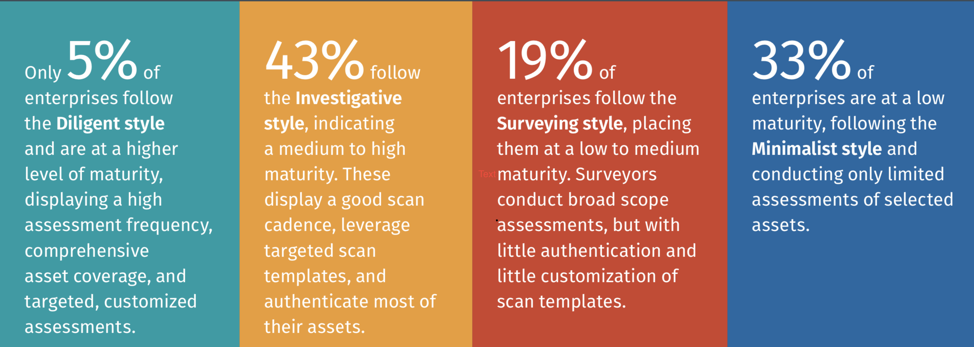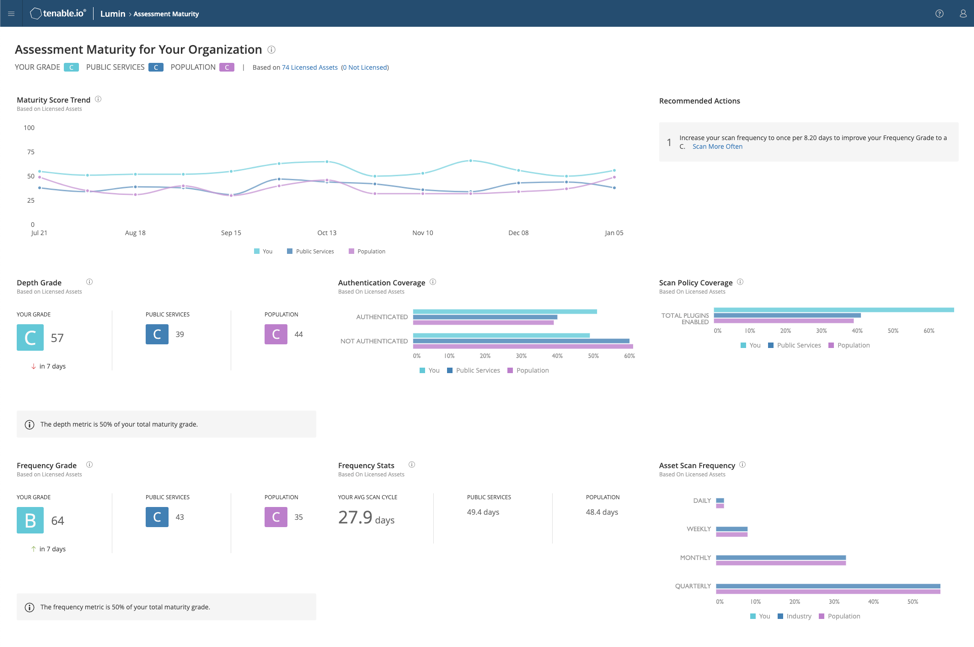Business system risk and process integrity risk are two essential metrics for a mature risk-based vulnerability management practice. With new assessment maturity scoring, Tenable Lumin now gives you insights into both.
Risk-based vulnerability management requires metrics addressing two types of risks:
- Business system risk
- Process integrity risk
Reducing business system risk requires understanding which assets are most critical to your organization and which vulnerabilities on those assets pose the greatest likelihood of being exploited. Business system risk measurements have been the foundation of Tenable Lumin to date.
Meanwhile, process integrity risk is the exposure your organization faces due to inadequate vulnerability management procedures. Understanding your process integrity risk can help you answer questions like:
- What critical processes (e.g., scanning frequency and depth) need to be improved?
- What new processes/directives should we undertake?
- How do our processes compare with others in my industry?
- Am I optimizing my assessment efforts by business unit, geography and asset groups?
Reducing process integrity risk involves understanding remediation effectiveness and assessment maturity, a single metric that quantifies and compares how well your organization is assessing your environment for vulnerabilities.
Unfortunately, many organizations do not take a mature approach to process integrity. In their Cyber Defender Strategies report, Tenable Research found that 52% of organizations have a low to medium level of maturity when it comes to their vulnerability assessment. Only 5% follow a diligent style with high assessment frequency, comprehensive asset coverage and targeted, customized assessments.

Source: Cyber Defender Strategies: What Your Vulnerability Assessment Practices Reveal
If your vulnerability assessment processes are lacking in frequency and completeness, you might be avoiding a serious breach through sheer luck. Taking a more diligent approach is the smarter choice.
Assessment maturity: A gauge of vulnerability management process integrity risk
Assessment maturity scoring, now incorporated into Tenable Lumin, provides metrics for assessing process integrity risk – and thus implementing policy and process improvements. It helps answer the why behind your cyber exposure status with insights and recommended actions to reduce your exposure. Specifically, it provides information on the degree to which you should increase scan frequency, plugin coverage and authentication. It also identifies pockets of differences within your organization and against industry peers.
Assessment maturity metrics
Assessment maturity is a new metric found in Tenable Lumin that quantifies how well your organization is scanning your environment. It provides this insight by computing two underlying components:
- Scan frequency: How frequently do you scan each asset in your network? This metric is calculated based on the number of unique days an asset was scanned during a given time window.
- Scan depth: How deeply or thoroughly do you scan each asset for vulnerabilities? This metric is a function of the number of plugins included in a scan and whether or not the asset was successfully authenticated.
The assessment maturity score combines scan frequency and scan depth into a single number. The assessment maturity score for a group of assets is the average of the assessment maturity scores for the individual assets.
Assessment maturity grade
Tenable Lumin assigns your organization a grade for your scan frequency, scan depth and overall assessment maturity scores, along with comparisons to industry peers and the overall population. Using this grading, you can compare your efforts to others and improve your processes accordingly.
Recommended actions
Tenable Lumin provides explicit recommendations on how you can reduce your process integrity risk such as including policy templates and scheduling the frequency and depth of scans.
Remediation effectiveness (how old is the unremediated vulnerability?)
To reduce process integrity risk, you also need to look at remediation effectiveness. One key metric providing insight into the effectiveness of remediation processes is the age of the unremediated vulnerabilities resident in your organization. Tenable Lumin provides insight into the length of time vulnerabilities have existed on your systems with information on the criticality of assets and priority rating of the vulnerabilities.
Reducing your Cyber Exposure Score – recommended actions
To reduce your risk in the most effective manner, Tenable Lumin also provides a prioritized list of the set of recommended actions that will have the most impact on reducing your Cyber Exposure Score.

Source: Tenable

